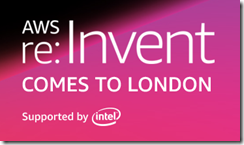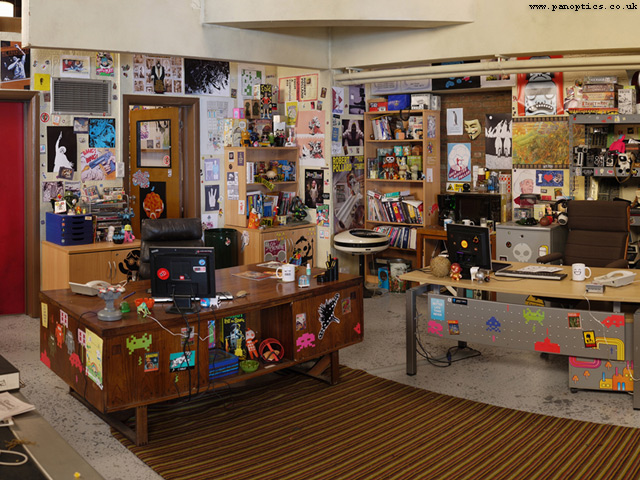AWS re:Invent comes to London
Last week (January 2019) I attended an AWS event in London to learn a bit more about Amazon Web Services and catch up on the big announcements from the November re:Invent conference held in Las Vegas. This is my write up of that one day event held at the Altitude360 tower in the capital.

Keynote
After an (unusual) request for no phones or photography during the session the day kicked off with a Keynote from Chris Hayman. Chris started with the overview of AWS’s majority market share and highlighted some of their millions of customers. Pie charts and graphs showed just how dominant Amazon is in this sector.
He then went on to touch on the large portfolio of products in the AWS stable- this featured a slide with so many product names that even sat in the front row looking at this cinema sized screen I wasn’t able to make them all out. This gamut continued throughout the day- by lunchtime I estimated I’d been introduced to at least fifty different products from the range. This is all a bit overwhelming- “how am I going to learn about all of these?” I was thinking.
But then I had something of an epiphany- stop thinking of these as discrete apps like I would with a traditional server setup and instead think of them as components or features of the overall single package. For example- in AWS you have a product called “[Amazon Route 53](https://aws.amazon.com/route53/” which provides a DNS service, there’s “AWS Transfer for SFTP”, “Amazon Elastic Block Store”, “AWS Systems Manager”. Back on your Windows Server you’d refer to these as the DNS, IIS, iSCSI Target, or Server Manager roles or services. This isn’t to say they are all equivalent between vendors, but thinking of these AWS product lines as services under the same umbrella platform helped bridge the gap from the more traditional way of thinking.
Learning all about #AWS today, I think I've heard over 50 product names and counting. All a bit overwhelming until I started thinking of them as just features of the overall service.
— Chris Bradshaw (@aldershotchris) January 24, 2019
This proliferation of names and features does make writing up the conference without it becoming a list of products a little tricky so this post will focus on my highlights from the day with links to product pages etc. where appropriate. If you do want a full list, the “Products” link at the top of the AWS website will fill you in.
Along with a high level view of the announcements from re:Invent, the keynote also included a few customer stories- EMIS group who provide software and IT services to the NHS, the London Borough of Waltham Forest who are using AWS to leverage the data they collect to help citizens in their region, and LGSS Digital who are using Amazon Connect to provide AI powered call centres for local authorities.
Following the Keynote the day split into a Business and Technical track. I favoured the latter, opting to stay in the windowless basement theatre when the Business track left for the 28-floor elevator ride to their views across London. Better to focus on the content rather than be distracted by the busy cityscape below :)
Core Services
The first session covered the Core Services in a bit more detail, starting off with the EC2 compute power that everything hinges on. We delved into the instance types available, from the new Graviton ARM processors (A1) through to the high-end compute with 4GHz Xeon cores (z1d).
In the storage part of the talk there were a couple of new features that caught my attention- notably the Managed File System offerings- FSx. The Windows version of this provides an AD-integrated DFS file-share with all the multi-availability-zone global resilience that the public cloud offers. A second service of note was the Glacier Deep Archive which offers storage at about $1/TB/month with a 12 hour recovery time for all those files that have to be kept for long periods but won’t be needed in a hurry.
Networking and Security came up next- one of the interesting things here was the “AWS Security Hub” which brings together all the AWS security products in one place. There’s a growing number of discrete products in the AWS security sphere (as with their other product groups) so having one system to manage them all makes a lot of sense.
Dev Tools and Containers
The afternoon sessions started with one covering developer tools, containers, and microservices. A big takeaway for me here was how AWS supports a development environment where multiple teams are using multiple languages to develop these microservices that need to all talk to each other for the application as a whole to work. The complicated nature of this needs management and visibility of the components as well as consistent communications between them. Features such as the preview “AWS App Mesh” and “AWS Cloud Map” can help developers with this challenge.
DB, AI, and ML
A quick dive into the world of databases, data lakes, data warehouses, ledgers, and blockchain came next. Again, every variant comes with a product name and there’s some inconsistency here- some products such as “Amazon Managed Blockchain” or “Amazon DocumentDB” have a name that clearly shows what they do, whilst others such as “Amazon Neptune” or “Amazon Aurora” leave you guessing. Thankfully they haven’t all been reduced to acronyms across the marketing and documentation -we have S3, RDS, EC2 etc but fifty+ of those would definitely get confusing.
My highlight of the section on AI and Machine Learning was our quick look at the the “AWS DeepRacer”- a scale model car which you can go out and buy and then teach to drive itself. During the break we got to see it whizz up and down the stage.
Internet of Everything Else
We were next introduced to the wide range of IoT services available on AWS. These are split into 3 categories: Data, Control, and Device. There’s lots of interesting developments happening here with Amazon working with the endpoints collecting the data- perhaps integrating with legacy equipment using “AWS IoT Sitewise”- and then storing, before analysing and acting upon it.
The final session was left to cover “Everything Else”- all those things that didn’t fit into one of the above categories. This included the VMware supported AWS Outposts where Amazon hardware can be hosted in your own datacentre and, bizarrely given the audience, a look at the AWS “Groundstation as a service” offering in case you have a satellite you need to talk to.
Summary
Overall this was an interesting excursion into the world of AWS even if it was solid PowerPoint for every session. The opportunity to drink direct from the firehose of information and then have face to face discussions with the team from Amazon on how to apply it in my own environment was definitely worth the time, and I look forward to finding out more. Details on their future events can be found here: aws.amazon.com/events/
